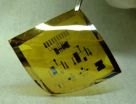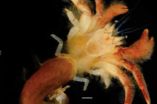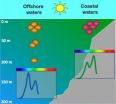(Press-News.org) PHILADELPHIA — Electronic circuits are typically integrated in rigid silicon wafers, but flexibility opens up a wide range of applications. In a world where electronics are becoming more pervasive, flexibility is a highly desirable trait, but finding materials with the right mix of performance and manufacturing cost remains a challenge.
Now a team of researchers from the University of Pennsylvania has shown that nanoscale particles, or nanocrystals, of the semiconductor cadmium selenide can be "printed" or "coated" on flexible plastics to form high-performance electronics.
The research was led by David Kim, a doctoral student in the Department of Materials Science and Engineering in Penn's School of Engineering and Applied Science; Yuming Lai, a doctoral student in the Engineering School's Department of Electrical and Systems Engineering; and professor Cherie Kagan, who has appointments in both departments as well as in the School of Arts and Sciences' Department of Chemistry. Benjamin Diroll, a doctoral student in chemistry, and Penn Integrates Knowledge Professor Christopher Murray of Materials Science and of Chemistry also collaborated on the research.
Their work was published in the journal Nature Communications.
"We have a performance benchmark in amorphous silicon, which is the material that runs the display in your laptop, among other devices," Kagan said. "Here, we show that these cadmium selenide nanocrystal devices can move electrons 22 times faster than in amorphous silicon."
Besides speed, another advantage cadmium selenide nanocrystals have over amorphous silicon is the temperature at which they are deposited. Whereas amorphous silicon uses a process that operates at several hundred degrees, cadmium selenide nanocrystals can be deposited at room temperature and annealed at mild temperatures, opening up the possibility of using more flexible plastic foundations.
Another innovation that allowed the researchers to use flexible plastic was their choice of ligands, the chemical chains that extend from the nanocrystals' surfaces and helps facilitate conductivity as they are packed together into a film.
"There have been a lot of electron transport studies on cadmium selenide, but until recently we haven't been able to get good performance out of them," Kim said. "The new aspect of our research was that we used ligands that we can translate very easily onto the flexible plastic; other ligands are so caustic that the plastic actually melts."
Because the nanocrystals are dispersed in an ink-like liquid, multiple types of deposition techniques can be used to make circuits. In their study, the researchers used spincoating, where centrifugal force pulls a thin layer of the solution over a surface, but the nanocrystals could be applied through dipping, spraying or ink-jet printing as well.
On a flexible plastic sheet a bottom layer of electrodes was patterned using a shadow mask — essentially a stencil — to mark off one level of the circuit. The researchers then used the stencil to define small regions of conducting gold to make the electrical connections to upper levels that would form the circuit. An insulating aluminum oxide layer was introduced and a 30-nanometer layer of nanocrystals was coated from solution. Finally, electrodes on the top level were deposited through shadow masks to ultimately form the circuits.
"The more complex circuits are like buildings with multiple floors," Kagan said. "The gold acts like staircases that the electrons can use to travel between those floors."
Using this process, the researchers built three kinds of circuits to test the nanocrystals performance for circuit applications: an inverter, an amplifier and a ring oscillator.
"An inverter is the fundamental building block for more complex circuits," Lai said. "We can also show amplifiers, which amplify the signal amplitude in analog circuits, and ring oscillators, where 'on' and 'off' signals are properly propagating over multiple stages in digital circuits."
"And all of these circuits operate with a couple of volts," Kagan said. "If you want electronics for portable devices that are going to work with batteries, they have to operate at low voltage or they won't be useful."
With the combination of flexibility, relatively simple fabrication processes and low power requirements, these cadmium selenide nanocrystal circuits could pave the way for new kinds of devices and pervasive sensors, which could have biomedical or security applications.
"This research also opens up the possibility of using other kinds of nanocrystals, as we've shown the materials aspect is not a limitation any more," Kim said.
INFORMATION:
The research was supported by the U.S. Department of Energy and the National Science Foundation.
Penn researchers make flexible, low-voltage circuits using nanocrystals
2012-11-27
ELSE PRESS RELEASES FROM THIS DATE:
Did you see that? How could you miss it?
2012-11-27
You may have received CPR training some time ago, but would you remember the proper technique in an emergency? Would you know what to do in the event of an earthquake or a fire? A new UCLA psychology study shows that people often do not recall things they have seen — or at least walked by — hundreds of times.
For the study, 54 people who work in the same building were asked if they knew the location of the fire extinguisher nearest their office. While many of the participants had worked in their offices for years and had passed the bright red extinguishers several times ...
Study advances use of stem cells in personalized medicine
2012-11-27
Johns Hopkins researchers report concrete steps in the use of human stem cells to test how diseased cells respond to drugs. Their success highlights a pathway toward faster, cheaper drug development for some genetic illnesses, as well as the ability to pre-test a therapy's safety and effectiveness on cultured clones of a patient's own cells.
The project, described in an article published November 25 on the website of the journal Nature Biotechnology, began several years ago, when Gabsang Lee, D.V.M., Ph.D., an assistant professor at the Johns Hopkins University School ...
Genome decoded: Scientists find clues to more disease-resistant watermelons
2012-11-27
ITHACA, N.Y. – Are juicier, sweeter, more disease-resistant watermelons on the way? An international consortium of more than 60 scientists from the United States, China, and Europe has published the genome sequence of watermelon (Citrullus lanatus) — information that could dramatically accelerate watermelon breeding toward production of a more nutritious, tastier and more resistant fruit. The watermelon genome sequence was published in the Nov. 25 online version of the journal Nature Genetics.
The researchers discovered that a large portion of disease resistance genes ...
Rapid changes in climate don't slow some lizards
2012-11-27
DURHAM, N.C. -- One tropical lizard's tolerance to cold is stiffer than scientists had suspected.
A new study shows that the Puerto Rican lizard Anolis cristatellus has adapted to the cooler winters of Miami. The results also suggest that this lizard may be able to tolerate temperature variations caused by climate change.
"We are not saying that climate change is not a problem for lizards. It is a major problem. However, these findings indicate that the thermal physiology of tropical lizards is more easily altered than previously proposed," said Duke biologist Manuel ...
Metabolic protein launches sugar feast that nurtures brain tumors
2012-11-27
HOUSTON - Researchers at The University of Texas MD Anderson Cancer Center have tracked down a cancer-promoting protein's pathway into the cell nucleus and discovered how, once there, it fires up a glucose metabolism pathway on which brain tumors thrive.
They also found a vital spot along the protein's journey that can be attacked with a type of drug not yet deployed against glioblastoma multiforme, the most common and lethal form of brain cancer. Published online by Nature Cell Biology, the paper further illuminates the importance of pyruvate kinase M2 (PKM2) in cancer ...
American University biologist discovers new crab species
2012-11-27
Areopaguristes tudgei. That's the name of a new species of hermit crab recently discovered on the barrier reef off the coast of Belize by Christopher Tudge, a biology professor at American University in Washington, D.C.
Tudge has been interested in biology his whole life, from boyhood trips to the beach collecting crustaceans in his native Australia, to his undergraduate and PhD work in zoology and biology at the University of Queensland. He has collected specimens all over the world, from Australia to Europe to North and South America.
Until now, he has never had ...
Study links improved consumer welfare to increased prescription drug advertising efforts
2012-11-27
Athens, Ga. – More people are better off thanks to the impact of an influx of direct-to-consumer advertising spending than they would be without those marketing efforts, according to a study recently published by Jayani Jayawardhana, an assistant professor in the University of Georgia College of Public Health.
The multi-year study focused on advertising efforts surrounding cholesterol-reducing prescription medications. Jayawardhana found increased levels of consumer welfare due to direct-to-consumer advertising than when compared to situations without this type of marketing. ...
SwRI team reports Cassini finds a video gamer's paradise at Saturn
2012-11-27
Call it "PAC-MAN, the Sequel." Scientists with NASA's Cassini mission have spotted a second feature shaped like the 1980s video game icon in the Saturn system, this time on the moon Tethys.
The pattern appears in thermal data obtained by Cassini's composite infrared spectrometer, with warmer areas making up the PAC-MAN shape.
"Finding a second PAC-MAN in the Saturn system tells us that the processes creating these 'PAC-MEN' are more widespread than previously thought," said Dr. Carly Howett, the lead author of a recently published paper in the journal Icarus. "The Saturn ...
IU-led team uncovers process for chameleon-like changes in world's most abundant phytoplankton
2012-11-27
An international team of biologists led by Indiana University's David M. Kehoe has identified both the enzyme and molecular mechanism critical for controlling a chameleon-like process that allows one of the world's most abundant ocean phytoplankton, once known as blue-green algae, to maximize light harvesting for photosynthesis.
Responsible for contributing about 20 percent of the total oxygen production on the planet, the cyanobacteria Synechococcus uses its own unique form of a sophisticated response called chromatic acclimation to fine tune the absorption properties ...
Newly insured patients may have trouble finding primary care physicians
2012-11-27
Implementation of the Affordable Care Act – now assured by the re-election of President Obama – is expected to result in up to 50 million currently uninsured Americans acquiring some type of health insurance coverage. But a study by researchers at the Mongan Institute for Health Policy at Massachusetts General Hospital (MGH) finds that a significant percentage of the primary care physicians most likely to care for newly insured patients may be not be accepting new patients. The investigators note that strategies designed to increase and support these "safety-net" physicians ...





